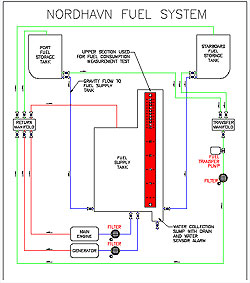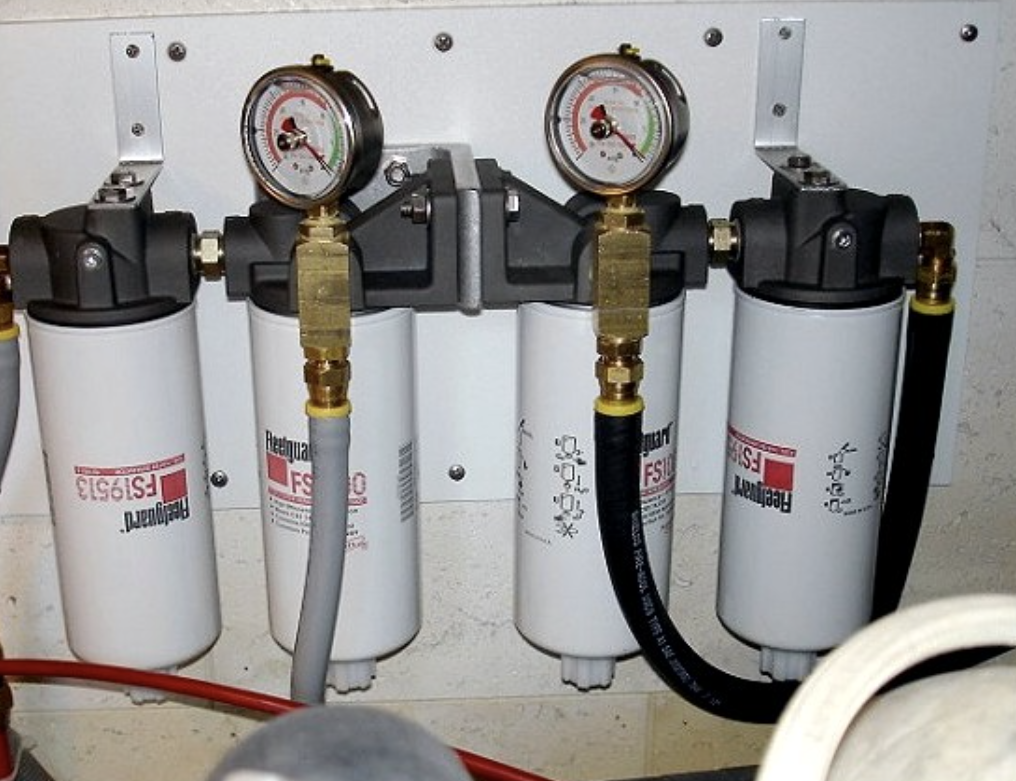Tech Talk - Fuel Confidence

A recent Passage Maker magazine article discussing fuel burn got some attention around here lately. The article (How Do You Know What You Burn?, March 2011) explained how the engine displays for electronic fuel injection diesel engines come up with their fuel burn figures by using a mapping algorithm that is dialed in during an engine’s development to ensure accuracy.
The writer further explained how it is prudent for a boater to test this accuracy by comparing what the engine display is reading to a known amount of fuel. His suggestion was to top off the tanks, burn a set amount of fuel per the engine display totalizer (like 100 gallons), and then refill the tanks to see just how close to 100 gallons the dockside pump meter reads when the tanks are full again – the closer the numbers are the more confident a boater would be to rely upon his engine display fuel information.
We certainly agree that fuel inventory management is critical to long-distance cruising, and anything that can aid a boater to accurately project fuel usage is more than welcome. We also agree that owners and captains should satisfy themselves that 2 gallons per hour on their electronic engine meters actually means 2 gallons of fuel are leaving the tanks each hour – no more, no less.
The method indicated in the Passage Maker article is one way to keep things honest, and it would work for any boat regardless of how the fuel system is set up. On a Nordhavn, however, the job becomes much easier thanks to a central fuel supply tank with a built-in fuel-consumption-measurement capability.
This is one of the reasons we read the Passage Maker story with such interest – instead of having to ask our owners to fill up, burn the tanks down, and then fill up again, we can just direct them to the existing fuel-consumption-measurement capability on their boats.
Understanding that fuel delivery and fuel management are such a crucial part of passagemaking, the Nordhavn fuel system has been designed to not only ensure every last drop of fuel is available for use, but also to ensure the ability to accurately measure the remaining amount of fuel on board and the amount of fuel being consumed at any time.
Fuel system configurations vary slightly from model to model, but each includes a central fuel supply tank mounted below the bottom level of the large fuel storage tanks. This allows the central supply tank to always have a gravity-fed fuel supply, which can quickly be isolated by valves at the supply tank and/or storage tanks.
This system mimics a typical high-wing light aircraft fuel system that also relies on gravity, not technology, to ensure every drop of fuel is available for use. The supply tank then supplies fuel directly to the engines, generators, etc.

Depending on the model, the supply tank can be just a few gallons or more than 80 gallons. In each case, however, the supply tank includes a sight-glass gauge and a precise graduated placard, usually in 1/10-gallon increments, to make accurate fuel consumption measurements.
The process is simple. The operator isolates the supply tank from the fuel storage tanks (return fuel from the engines is being returned to the supply tank), notes the tank level, and then comes back in 20 or 30 minutes and notes the new supply tank level – the difference being the amount of fuel burned (for instance, 3/4 of a gallon in 30 minutes would equal 1.5 gallons an hour).
Simple, accurate and easy – and a handy way to provide a real-time comparison with what the electronic engine displays are reading. Just doing this a few times would tell an owner whether his electronic engine displays are accurate enough to be relied upon for long-distance fuel planning.
Another nifty benefit of the fuel supply tank is that it creates a natural point for detecting and removing water from the system. Because the supply tank is situated lower than the fuel storage tanks (and water is heavier than fuel), any water that forms in the tanks from condensation will flow by gravity to the bottom of the fuel supply tank.
Knowing this to be the case, a small collection sump and drain are fitted at the bottom of the supply tank below the fuel pickups for the engines, which ensures the settled water will not be fed to the engines. A water-sensing alarm is fitted to the collection sump to alert the operator to the presence of water well in advance of it rising high enough to be introduced to the engines.
Anytime water is present the operator can simply drain it to a container or to the bilge.
One story that has become legend around here starts with an owner’s grandson accidently putting more than 200 gallons of water into one of the fuel storage tanks. What would typically have been a nightmare was remedied by simply giving the water a little time to settle and draining it out the bottom of the supply tank.
In addition to water finding its way to the bottom of the supply tank sump, a fair amount of debris can also settle there and be drained off instead of clogging up the filtration system.

Filtration, of course, is provided as a last defense against any kind of fuel contamination. In fact, contaminated fuel is of such a concern that all Nordhavns also have the ability to polish fuel before being sent to the primary and secondary fuel filters. The polishing system is essentially a dedicated filter placed in a transfer loop that allows fuel to be moved from storage tank to storage tank or storage tank to supply tank.
If an owner knows he has taken on some dirty fuel, he can simply batch feed the supply tank using this dedicated filter to clean the fuel before being sent to the primary filters and engines.
Confidence is a word that is used a lot when talking about fuel around here. Confidence that the fuel is as clean as it can be, confidence that a gravity-fed system is a smart strategy and confidence that fuel consumption figures are accurate so usage projections can be counted upon.
We applaud the engine builders for making the information their electronic displays provide as accurate as possible, and we commend Passage Maker for reminding us that it is our responsibility to take steps to satisfy ourselves that this information is usable.
We encourage any genuine effort to increase an owner’s ability to use his fuel system with confidence – and we love to hear stories of owners reaching a destination with just the amount of remaining fuel they calculated thanks to accurate information and diligent fuel management.